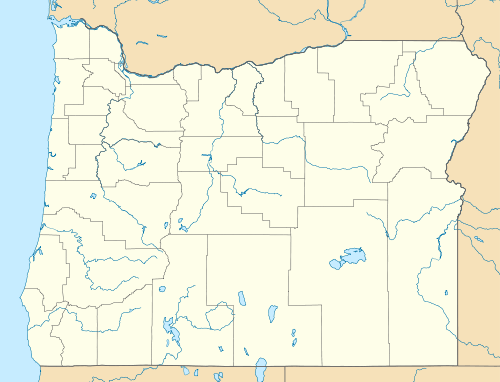Big Cliff Dam
| Big Cliff Dam | |
|---|---|
 Big Cliff Dam on the North Santiam River | |
 Location of Big Cliff Dam in Oregon | |
| Country | United States |
| Location | Linn County–Marion County, Oregon |
| Coordinates | 44°45′3.6″N 122°16′59.16″W / 44.751000°N 122.2831000°WCoordinates: 44°45′3.6″N 122°16′59.16″W / 44.751000°N 122.2831000°W |
| Purpose | Power |
| Status | Operational |
| Construction began | 1949 |
| Opening date | 1953 |
| Owner(s) | U.S. Army Corps of Engineers |
| Dam and spillways | |
| Type of dam | Concrete gravity |
| Impounds | North Santiam River |
| Height | 191 ft (58 m) |
| Length | 280 ft (85 m) |
| Elevation at crest | 1,212 ft (369 m) |
| Reservoir | |
| Creates | Big Cliff Lake |
| Total capacity | 6,450 acre·ft (7,960,000 m3) |
| Surface area | 128 acres (0.52 km2)[1] |
| Max. length | 2.8 mi (4.5 km) |
| Power station | |
| Commission date | 1953 |
| Turbines | 1 x 18 MW Kaplan-type[2] |
| Installed capacity | 18 MW |
Big Cliff Dam is a concrete gravity dam on the North Santiam River in the western part of the U.S. state of Oregon.[3] The dam spans the Linn County–Marion County border in the Oregon Cascades.
The dam's primary functions are flood control, power generation, irrigation, fish habitat, water quality improvement, and recreation. It is one of 13 dams created by the U.S. Army Corps of Engineers under the Willamette Valley Project which was authorized by the Flood Control Act of 1938.[4]
It was constructed between March 1949 and May 1953[5] at the same time as Detroit Dam. Big Cliff is 2.7 miles (4.3 km) river distance below Detroit Dam at river mile 47 of the North Santiam River.
Big Cliff smooths river flow resulting from power generation fluctuations of Detroit Dam, a practice known as river re-regulation. Big Cliff Reservoir, primarily known as Big Cliff Lake, has daily depth variations of up to 24 feet (7.3 m).[3]
Big Cliff can generate up to 18 megawatts of power.[3]
The dams' operators try to keep the water temperature in the 50 to 59 °F (10 to 15 °C) range for ideal fish habitat by mixing water from the top of Detroit Lake with water from the bottom.[6]
References
- ↑ "Detroit Lake Temperature and Suspended Sediment Model". U.S. Geological Survey. Retrieved 10 January 2015.
- ↑ "Appendix A - Portland District - U.S. Army" (PDF). U.S. Army Corps of Engineers - Portland District. p. A-6. Retrieved 10 January 2015.
- 1 2 3 "Big Cliff". U.S. Army Corps of Engineers. Retrieved 2013-08-27.
- ↑ "Willamette BiOp". Federal Caucus. Retrieved 2013-08-27.
- ↑ Jamie Wyant (2012-06-12). "The Detroit and Big Cliff dams". North Santiam Watershed Council. Retrieved 2013-08-27.
- ↑ Alex Paul (2009-08-04). "Corps of Engineers making repairs on Big Cliff Dam gates". Albany Democrat-Herald. Retrieved 2013-08-27.
Echols said, "For a while, the water temperature got to about 68 degrees and we would like it to be in the 50s. We were able to mitigate that by running water from the power house, which is very cold, and mixing it in Big Cliff reservoir. That helped balance the temperature."
External links
![]() Media related to Big Cliff Dam at Wikimedia Commons
Media related to Big Cliff Dam at Wikimedia Commons
- 720p Video 'Tainter gates at Big Cliff Dam' shot below the gates
- USACE Detroit/Big Cliff Dams Interim Temperature Operations Study Phase I Technical Report (PDF) provides data for water quality, temperature, power generation, salmon egg viability, fish catch rate, etc.
- Big Cliff recent telemetry (PDF)